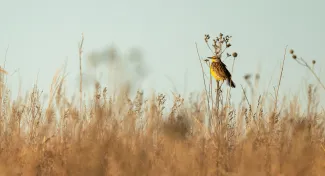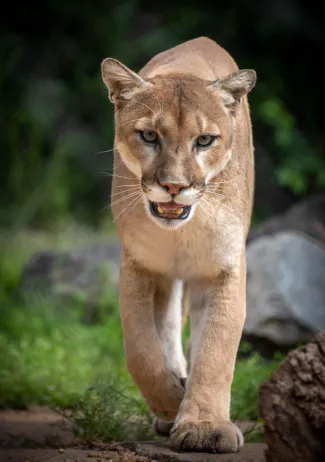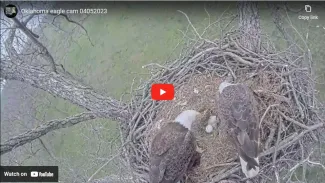Conservation Partnerships
Between managing habitat, surveying Oklahoma’s fish and wildlife, and sharing about the state’s incredible species, we know that many hands don’t just make “light work,” they make conservation work. The helping hands of like-minded partners stretch the Wildlife Department’s resources to make an even bigger impact on Oklahoma’s natural resources and people who enjoy the outdoors. To prove that many hands make conservation work, we’re showcasing the diverse efforts of three of our valuable conservation partnerships.
The Nature Conservancy
The Oklahoma Chapter of the Nature Conservancy was formed in 1986, with the overarching mission to conserve the lands and waters on which all life depends.

The Joseph H. Williams Tallgrass Prairie Preserve is one of 12 places The Nature Conservancy protects in Oklahoma. Though best known for its bison herd, other prairie wildlife like western meadowlarks can be observed and photographed at the preserve. (Angie Precure/Readers’ Photography Showcase 2023)
Habitat protection, a vital component of conservation, is a leading charge of The Nature Conservancy. In Oklahoma, this nonprofit, charitable organization has worked to protect the magnificent landscapes and unique biodiversity on 12 preserves encompassing more than 100,000 acres. From the bison herd at the Joseph H. Williams Tallgrass Prairie Preserve, to ancient oaks and cedars in the Keystone Ancient Forest Preserve, and impressive views of the High Plains at the Black Mesa Preserve, visitors can explore and learn, as well as volunteer and be part of these important places. Though some of The Nature Conservancy’s preserves are closed to the public, others offer limited access including hiking opportunities during daylight hours.
In addition to habitat restoration and stewardship on their own lands, The Nature Conservancy also helps landowners conserve their properties through easements and has been a strong advocate of native landscaping and gardening, prescribed fire, siting wind right, and protecting aquifers and watersheds.
Learn More About The Nature Conservancy
The Oklahoma City Zoo
Since its opening in 1902, the Oklahoma City Zoo has connected people with our world’s vanishing wildlife and wild places to inspire conservation action.

The Oklahoma City Zoo's award-winning Oklahoma Trails exhibit allows visitors to closely observe and learn about Oklahoma’s native wildlife, including mountain lions. (Dr. Jennifer D'Agostino, OKC Zoo)
During their visit, guests of the Oklahoma City Zoo can expect to explore the world’s amazing animal life and their incredible habitats. But they may also be surprised to encounter more than 100 species native to Oklahoma! The eight-acre Oklahoma Trails exhibit is designed around the state’s diverse ecoregions and is home to a variety of animals. From mountain lions to American alligator, greater roadrunners to alligator snapping turtle, and sandhill cranes to northern river otter, the Oklahoma City Zoo offers an exciting and up-close perspective of Outdoor Oklahoma.
Beyond the public exhibits, the Oklahoma City Zoo has been involved in a variety of Oklahoma-based conservation projects. In addition to being a leader in monarch conservation efforts across the state and helping local schools create pollinator gardens, Zoo staff have helped with habitat projects on The Nature Conservancy’s preserves, assisted with annual bird and bat surveys, and have tracked Texas horned lizards as part of a long-term study at Tinker Air Force Base.
Learn More About the Oklahoma City Zoo
Sutton Avian Research Center
Founded in 1983, the George Miksch Sutton Avian Research Center works to find cooperative conservation solutions for birds and the natural world through science and education.

The Sutton Center has long been dedicated to the conservation of bald eagles in Oklahoma and maintains a live eagle cam most years. Though the camera is currently being repaired after weather complications, archived videos, including this clip from April 2023, are available from previous nesting seasons.
The bald eagle and its recovery from devastating population declines was at the heart of the Sutton Avian Research Center’s creation. Through their captive-rearing program, 275 bald eagles were released into Oklahoma and four other states from 1985-1992, bolstering the population and ensuring our nation’s bird endures. In the organization’s 40 years, Oklahoma’s nesting bald eagle population has gone from zero to more than 300 pairs! The Sutton Center remains dedicated to the bald eagle and conducts annual surveys for the bird’s distinctive nests and monitors their status with the help of their “BEST” volunteers, the Bald Eagle Survey Team.
The return of the bald eagle to Oklahoma may be the crowning achievement of the Bartlesville-based research center, but the organization has made strides in conserving a number of other species. Captive breeding programs to boost other wild bird populations have been established for two species: the endangered Attwater’s prairie-chicken, a subspecies of greater prairie-chicken found in coastal Texas, and the masked bobwhite, an endangered subspecies of northern bobwhite found in Arizona and Mexico. Extensive breeding bird surveys throughout Oklahoma, including “saturation” surveys for lesser prairie-chickens, have also been conducted with financial support from the Wildlife Department. Conservation-themed live bird education programs are offered at a number of schools along with a statewide high school art competition that provides scholarship funds to Oklahoma students who communicate a current conservation topic through art and essay.
Learn More About the Sutton Center
Just as these organizations partner with the Wildlife Department to conserve Oklahoma's natural resources, they have also formed partnerships with each other! The Oklahoma City Zoo has partnered with both The Nature Conservancy and Sutton Avian Research Center to help improve habitat conditions and survey Oklahoma's bird communities.